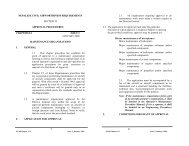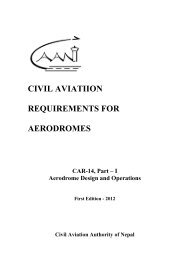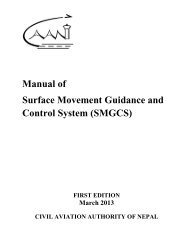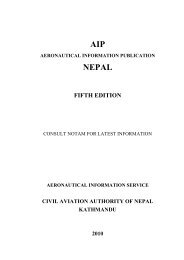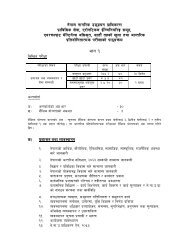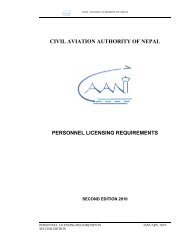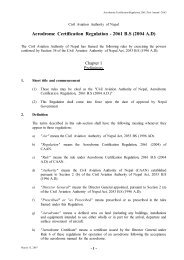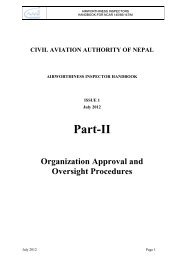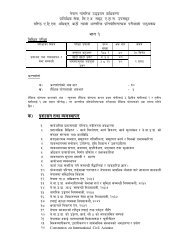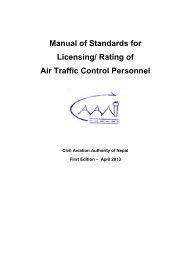Audit Policy and Procedure Manual - Civil Aviation Authority of Nepal
Audit Policy and Procedure Manual - Civil Aviation Authority of Nepal
Audit Policy and Procedure Manual - Civil Aviation Authority of Nepal
Create successful ePaper yourself
Turn your PDF publications into a flip-book with our unique Google optimized e-Paper software.
<strong>Audit</strong> <strong>Policy</strong> <strong>and</strong> <strong>Procedure</strong> <strong>Manual</strong>ISSUE 2June 2013Issued by<strong>Civil</strong> <strong>Aviation</strong> <strong>Authority</strong> <strong>of</strong> <strong>Nepal</strong>
<strong>Civil</strong> <strong>Aviation</strong> authority <strong>of</strong> <strong>Nepal</strong><strong>Audit</strong> <strong>Policy</strong> <strong>and</strong> <strong>Procedure</strong> <strong>Manual</strong><strong>Audit</strong> <strong>Policy</strong> <strong>and</strong> <strong>Procedure</strong> <strong>Manual</strong>This is an internal CAA <strong>Nepal</strong> policy manual. It contains guidance material intended to assist CAA <strong>Nepal</strong>employees <strong>and</strong> delegates in carrying out their regulatory responsibilities <strong>and</strong> may be made available to thepublic for information purposes only.Reference should always be made to the applicable provisions <strong>of</strong> the <strong>Civil</strong> <strong>Aviation</strong> Act <strong>and</strong> <strong>Civil</strong> aviationRegulations, rather than this manual, to ascertain the requirements <strong>of</strong>, <strong>and</strong> the obligations imposed by orunder, the civil aviation legislation.Issue 2June 2013i
<strong>Audit</strong> <strong>Policy</strong> <strong>and</strong> <strong>Procedure</strong> <strong>Manual</strong><strong>Civil</strong> <strong>Aviation</strong> authority <strong>of</strong> <strong>Nepal</strong>Records <strong>of</strong> RevisionRevision No Date <strong>of</strong> Revision Incorporated By Date IncorporatedIssue 2June 2013iv
<strong>Audit</strong> <strong>Policy</strong> <strong>and</strong> <strong>Procedure</strong> <strong>Manual</strong><strong>Civil</strong> <strong>Aviation</strong> authority <strong>of</strong> <strong>Nepal</strong><strong>Manual</strong> RevisionsThis <strong>Audit</strong> <strong>Policy</strong> <strong>and</strong> <strong>Procedure</strong> <strong>Manual</strong> will be subject to on-going review <strong>and</strong> revision. Personsidentifying errors or omissions, or those wishing to make recommendations for change, are asked t<strong>of</strong>orward their observations to the Director General <strong>of</strong> <strong>Civil</strong> <strong>Aviation</strong> <strong>Authority</strong> <strong>of</strong> <strong>Nepal</strong>.Issue 2June 2013v
<strong>Audit</strong> <strong>Policy</strong> <strong>and</strong> <strong>Procedure</strong> <strong>Manual</strong><strong>Civil</strong> <strong>Aviation</strong> authority <strong>of</strong> <strong>Nepal</strong>Table <strong>of</strong> ContentIssue 2June 2013ContentsPage NoForewordiiList <strong>of</strong> Effective pageiiiRecord <strong>of</strong> Revisioniv<strong>Manual</strong> RevisionsvTable <strong>of</strong> Contentvi- viiiChapter 1 - Definitions 11.1 Definitions 11.2 Abbreviations And Acronyms 2Chapter 2 - <strong>Audit</strong> <strong>Policy</strong> 52.1 Introduction 52.1.1 Director General, <strong>Civil</strong> <strong>Aviation</strong> 52.1.2 <strong>Audit</strong> <strong>Policy</strong> <strong>and</strong> <strong>Procedure</strong> <strong>Manual</strong> 52.1.3 Functional Area <strong>Procedure</strong> <strong>Manual</strong>s 52.1.4 <strong>Audit</strong> Program 52.1.5 <strong>Audit</strong> Unit 52.2 <strong>Authority</strong> 62.2.1 Inspector Delegation <strong>of</strong> <strong>Authority</strong> 62.3 inspectors Regulatory Powers 62.4 <strong>Audit</strong> Types 62.4.1 Approval or Certification <strong>Audit</strong> 62.4.2 Routine Compliance <strong>Audit</strong> 62.4.3 Special-Purpose <strong>Audit</strong> 62.5 <strong>Audit</strong> Classification 72.6 Scope 72.6.1 Criteria 72.6.2 Consultation Requirement 72.7 Frequency 72.8 Overseas <strong>Audit</strong> Budgets 72.8.1 General 72.9 <strong>Audit</strong> Phases 82.9.1 Pre - <strong>Audit</strong> 82.9.2 Physical <strong>Audit</strong> 82.9.3 Post-<strong>Audit</strong> 82.9.4 <strong>Audit</strong> Follow-up 82.10 Checklists 82.10.1 Purpose 82.10.2 Applicability 92.11 <strong>Audit</strong> Team 92.11.1 Inspector Assignments 92.11.2 Inspector Qualifications 92.11.3 Inspector Restrictions 92.11.4 <strong>Audit</strong> Co-ordination 92.11.5 Conflict <strong>of</strong> Interest 92.11.6 Specialists 10vi
<strong>Civil</strong> <strong>Aviation</strong> authority <strong>of</strong> <strong>Nepal</strong><strong>Audit</strong> <strong>Policy</strong> <strong>and</strong> <strong>Procedure</strong> <strong>Manual</strong>3.4.1.3 Report <strong>Procedure</strong>s 243.5 <strong>Audit</strong> Follow-Up 243.5.1 General 243.5.2 Types <strong>of</strong> Corrective Action 253.5.2.1 Short-Term Corrective Action 253.5.2.2 Long-Term Corrective Action 253.5.3 Corrective Action Plan Submission 253.5.4 Corrective Action Plan Approval 263.5.5 CAP Follow-up 263.5.5.1 Follow-up Process 263.5.5.2 <strong>Audit</strong> Follow-up 263.5.5.3 <strong>Audit</strong> Closure. 273.5.6 <strong>Audit</strong> Follow-up Action 283.5.7 <strong>Audit</strong> Report Review Committee 283.5.8 Post-<strong>Audit</strong> Surveillance 29Chapter 4 - <strong>Audit</strong> Team Requirements 314.1 Team Selection 314.2 Director General <strong>of</strong> <strong>Civil</strong> <strong>Aviation</strong> 314.2.1 Responsibilities 314.3 <strong>Audit</strong> Team Leader 314.3.1 Terms <strong>of</strong> Reference 314.3.2 Qualifications 324.3.3 Responsibilities 324.4 Team Member 334.4.1 Terms <strong>of</strong> Reference 334.4.2 Qualifications 344.4.3 Responsibilities 34Chapter 5 - Observation Findings 355.1 General 35Chapter 6 - Forms 376.1 General 376.2 <strong>Audit</strong> File reference 376.3 Tracking Process 37Appendix A 38Appendix B 39Issue 2June 2013viii
<strong>Civil</strong> <strong>Aviation</strong> authority <strong>of</strong> <strong>Nepal</strong><strong>Audit</strong> <strong>Policy</strong> <strong>and</strong> <strong>Procedure</strong> <strong>Manual</strong>1.1 DefinitionsIssue: 2Revision: 00Date: June 2013Chapter 1<strong>Audit</strong> plan - the annual plan <strong>of</strong> scheduled audits approved by the CAA <strong>Nepal</strong>;<strong>Audit</strong> program - the CAA <strong>Nepal</strong> program that promotes compliance with aviationregulatory requirements that collectively prescribe an acceptable level <strong>of</strong> aviation safety;<strong>Audit</strong> - an in-depth review <strong>of</strong> the activities <strong>of</strong> an organization to verify compliance withregulatory requirements;<strong>Audit</strong> activities - those activities <strong>and</strong> procedures through which information is obtained toverify compliance with regulatory requirements;<strong>Audit</strong>ee - the organization to be audited;<strong>Audit</strong> finding - non- compliance with a specified regulatory requirement, identified during anaudit <strong>and</strong> documented on a finding form;<strong>Audit</strong> manager – Chief <strong>of</strong> Division <strong>of</strong> FSSD (Chief AWID, Chief FOD)<strong>Audit</strong> team leader - the individual, designated by the FSSD, <strong>Civil</strong> <strong>Aviation</strong> <strong>Authority</strong> <strong>of</strong> <strong>Nepal</strong>,responsible for the planning <strong>and</strong> conduct <strong>of</strong> an audit;<strong>Audit</strong> report - a report that outlines the audit process <strong>and</strong> provides a summary <strong>of</strong> the auditfindings;Certification - the process <strong>of</strong> determining regulatory compliance <strong>and</strong> competencequalification.Characteristic - any distinct property or attribute <strong>of</strong> a product, process, service or practice<strong>of</strong> which compliance to a regulatory requirement can be measured;Combined audit - an audit that targets more than one functional area;Confirmation - the assurance that findings are in accordance with data obtained fromdifferent sources;Compliance - the state <strong>of</strong> meeting regulatory requirements;Corrective Action Plan (CAP) - a plan submitted in response to findings. The CAP outlineshow the organization proposes to correct the deficiencies documented in the findings;Documented - that which has been recorded in writing, photocopied or photographed <strong>and</strong>then signed, dated <strong>and</strong> retained;Finding - non- compliance with a regulatory requirement;Finding form - a form used to document a finding;Follow-up - the final audit phase that focuses on corrective action to findings issued duringan audit;Inspection - the basic activity <strong>of</strong> an audit, involving the systematic assessment <strong>of</strong> a specificcharacteristic <strong>of</strong> an organization to verify compliance with regulatory requirements. Theterm also refers to inspector tasks exercised in the performance <strong>of</strong> this activity;1
<strong>Civil</strong> <strong>Aviation</strong> authority <strong>of</strong> <strong>Nepal</strong>Issue: 2Revision: 00Date: June 2013<strong>Audit</strong> <strong>Policy</strong> <strong>and</strong> <strong>Procedure</strong> <strong>Manual</strong>Non- compliance - the failure to meet regulatory requirements;Observation finding - a subjective determination that identifies the possible need to revisea regulatory requirement or a non-regulatory CAA <strong>Nepal</strong> policy, procedure or guideline;Practice - the method by which a procedure is carried out;<strong>Procedure</strong> or process - a series <strong>of</strong> steps followed methodically to complete an activity.This includes: the activity to be done <strong>and</strong> individual(s) involved; the time, place <strong>and</strong>manner <strong>of</strong> completion; the materials, equipment, <strong>and</strong> documentation to be used; <strong>and</strong> themanner in which the activity is to be controlled;Quality Assurance Review (QAR) - a review that measures the level <strong>of</strong> compliance tonational policies, st<strong>and</strong>ards, procedures <strong>and</strong> guidelines;Scope - the number <strong>of</strong> functional areas, <strong>and</strong> specialty areas therein, that will beinspected, <strong>and</strong> the depth (back in time) <strong>of</strong> the review;Specialty audit - an audit that targets a single functional area;Specialty area - an area within a functional area that identifies common or similarrequirements <strong>and</strong> for which checklists are provided <strong>and</strong> named after that specialty area,or after specific elements within that specialty area;Sampling - the inspection <strong>of</strong> a representative portion <strong>of</strong> a particular characteristic toproduce a statistically meaningful assessment <strong>of</strong> the whole;St<strong>and</strong>ard - an established criterion used as a basis for measuring an organization's level <strong>of</strong>compliance;Team member - the individual appointed by the audit team leader to participate in an audit;Verification - an independent review, examination, measurement, testing, checking,observation <strong>and</strong> monitoring to establish <strong>and</strong> document that, processes, practices,services <strong>and</strong> documents conform to regulatory requirements. This includesconfirmation that an activity, condition or control conforms to the requirements specifiedin regulations, st<strong>and</strong>ards, specifications, program element descriptions, <strong>and</strong> technicalprocedures;Working papers - all documents required by the auditor or audit team to plan <strong>and</strong>implement the audit. These may include inspection schedules, assignments, checklists <strong>and</strong>various report forms.1.2 Abbreviations <strong>and</strong> AcronymsThe following abbreviations <strong>and</strong> acronyms will be found throughout this manual <strong>and</strong> inrespective functional area procedure manuals, including checklists <strong>and</strong> other guidancematerials:FSSD- Flight Safety St<strong>and</strong>ards DepartmentAWID- Airworthiness Inspection DivisionCAA <strong>Nepal</strong>- <strong>Civil</strong> <strong>Aviation</strong> <strong>Authority</strong> <strong>of</strong> <strong>Nepal</strong>CAP- Corrective Action Plan2
<strong>Civil</strong> <strong>Aviation</strong> authority <strong>of</strong> <strong>Nepal</strong><strong>Audit</strong> <strong>Policy</strong> <strong>and</strong> <strong>Procedure</strong> <strong>Manual</strong>CEO- Chief Executive OfficerDG- Director General <strong>of</strong> <strong>Civil</strong> <strong>Aviation</strong> <strong>Authority</strong> <strong>of</strong> <strong>Nepal</strong>FOS- Flight Operation SectionICAO- International <strong>Civil</strong> <strong>Aviation</strong> OrganizationMORS- M<strong>and</strong>atory Occurrence Reporting SystemQA - Quality AssuranceQAR- Quality Assurance ReviewSMS- Safety Management SystemIssue: 2Revision: 00Date: June 20133
<strong>Civil</strong> <strong>Aviation</strong> authority <strong>of</strong> <strong>Nepal</strong><strong>Audit</strong> <strong>Policy</strong> <strong>and</strong> <strong>Procedure</strong> <strong>Manual</strong>Intentionally Left BlankIssue: 2Revision: 00Date: June 20134
<strong>Civil</strong> <strong>Aviation</strong> authority <strong>of</strong> <strong>Nepal</strong><strong>Audit</strong> <strong>Policy</strong> <strong>and</strong> <strong>Procedure</strong> <strong>Manual</strong>2.1 IntroductionChapter 2<strong>Audit</strong> <strong>Policy</strong>2.1.1 Director General, <strong>Civil</strong> <strong>Aviation</strong> <strong>Authority</strong> <strong>of</strong> <strong>Nepal</strong>The Director General <strong>of</strong> <strong>Civil</strong> <strong>Aviation</strong> <strong>Authority</strong> <strong>of</strong> <strong>Nepal</strong> is responsible for the development<strong>of</strong> audit <strong>and</strong> inspection policy <strong>and</strong> procedures.2.1.2 <strong>Audit</strong> <strong>Policy</strong> <strong>and</strong> <strong>Procedure</strong> <strong>Manual</strong>This manual outlines general audit policy <strong>and</strong> procedures <strong>and</strong> serves as the principalguidance document for the conduct <strong>of</strong> audits carried out by the CAA <strong>Nepal</strong>.Note: The policy <strong>and</strong> procedures outlined in this manual are also applicable to inspections conducted at timesother than during audits. Although such inspections may be less formal in planning <strong>and</strong> execution, theprinciples outlined in this manual remain same; this is especially true as it pertains to using checklists,documenting findings, obtaining corrective actions <strong>and</strong> following up to ensure that such corrective actions areeffective. Additional guidance on this may be provided in the appropriate functional area procedure manual.2.1.3 Functional Area <strong>Audit</strong>The Functional Area audit is specific to the particular area. The inspector uses checklists,forms <strong>and</strong> guidance materials that will be used in the course <strong>of</strong> their audit <strong>and</strong> inspectionactivities. This material is made available to inspectors in the Airworthiness InspectorH<strong>and</strong>book <strong>and</strong> Flight Operations Inspector H<strong>and</strong>book.The appointed person having responsibility for a specific audit area is responsible forupdating <strong>and</strong> promulgating information contained in these documents.2.1.4 <strong>Audit</strong> ProgramThe <strong>Audit</strong> Program has been developed to promote compliance with the related ICAOAnnexes <strong>and</strong> associated st<strong>and</strong>ards.2.1.5 <strong>Audit</strong> UnitThe respective unit director/Chief <strong>of</strong> Division, through the CAAN, is responsible for themanagement <strong>of</strong> the <strong>Audit</strong> Program, which includes the following:(a)(b)(c)(d)(e)defining audit policy, procedures <strong>and</strong> st<strong>and</strong>ards;ensuring that audits are conducted by qualified inspectors;maintaining the <strong>Audit</strong> <strong>Policy</strong> <strong>and</strong> <strong>Procedure</strong> <strong>Manual</strong> <strong>and</strong> assisting in the development<strong>and</strong> management <strong>of</strong> functional area procedure manuals;administering the program to ensure that audit policies <strong>and</strong> procedures areapplied uniformly; <strong>and</strong>co-ordinating audits conducted under the <strong>Audit</strong> Plan.Issue: 2Revision: 00Date: June 20135
<strong>Civil</strong> <strong>Aviation</strong> authority <strong>of</strong> <strong>Nepal</strong>2.2 <strong>Authority</strong><strong>Audit</strong> <strong>Policy</strong> <strong>and</strong> <strong>Procedure</strong> <strong>Manual</strong><strong>Audit</strong>s <strong>and</strong> Inspections <strong>and</strong> are conducted pursuant to <strong>Civil</strong> <strong>Aviation</strong> Act 1959 <strong>and</strong> <strong>Civil</strong><strong>Aviation</strong> Regulations 2002.2.2.1 Inspector Delegation <strong>of</strong> <strong>Authority</strong>Inspectors receive the authority to conduct inspections through delegation <strong>of</strong> authorityissued by the Director <strong>of</strong> Department <strong>and</strong> Chief <strong>of</strong> Division.2.3 Inspector Regulatory PowersInspectors are delegated the authority to exercise regulatory powers whenencountering a situation where there is an imminent threat to aviation safety.Inspectors are expected to use judgment <strong>and</strong> tact in dealing with such matters where theover-riding factor is safety to persons <strong>and</strong> property.Although an inspector cannot permit a threat to safety to persist, it is important that theorganization under review be advised <strong>of</strong> the specific safety concerns <strong>and</strong> be given theopportunity to address the situation voluntarily. Where applicable <strong>and</strong> possible, the auditteam leader <strong>and</strong>/or manager shall also be consulted.2.4 <strong>Audit</strong> TypesThe type <strong>of</strong> audit is determined by the circumstances under which the audit is convened<strong>and</strong> includes the following:(a)(b)(c)approval or certification audit;routine compliance audit; <strong>and</strong>special-purpose audit2.4.1 Approval or Certification <strong>Audit</strong>Once an application for an approval or certification <strong>of</strong> a specific discipline is received, anaudit will be conducted to ensure that approval <strong>and</strong> certification requirements have beenmet.2.4.2 Routine Compliance <strong>Audit</strong>A routine compliance audit will be conducted for the purpose <strong>of</strong> determining anorganization's overall level <strong>of</strong> compliance with regulatory requirements. All applicablecharacteristics <strong>of</strong> the organization will be subject to review.2.4.3 Special-Purpose <strong>Audit</strong>A special-purpose audit is one conducted to respond to circumstances other than thoserequiring a post-approval or certification audit, or a routine compliance audit. For example,a special-purpose audit may be convened with little or no notice arising from safety concerns.A "no-notice" audit may preclude certain team-member activities <strong>and</strong> responsibilities thatwould be normally associated with other types <strong>of</strong> audits.Issue: 2Revision: 00Date: June 20136
<strong>Civil</strong> <strong>Aviation</strong> authority <strong>of</strong> <strong>Nepal</strong>2.5 <strong>Audit</strong> Classification2.6 Scope<strong>Audit</strong> <strong>Policy</strong> <strong>and</strong> <strong>Procedure</strong> <strong>Manual</strong><strong>Audit</strong>s are classified as "combined" or "specialty". A combined audit will target more thanone functional area whereas a specialty audit will focus on specialty areas, or elements(checklists) there<strong>of</strong>, within a single functional area.2.6.1 CriteriaThe scope <strong>of</strong> an audit is influenced by the following:(a)(b)(c)(d)(e)(f)the type <strong>and</strong> classification <strong>of</strong> the audit;the period back in time that systems are subject to review (typically from thelast audit to the present);the enforcement record <strong>of</strong> the organization;the time since the last audit (frequency <strong>of</strong> inspection);the confidence in corrective actions taken by the organization as a result <strong>of</strong> aprevious audit; <strong>and</strong>inspector availability.2.6.2 Consultation RequirementFor other than routine compliance audits, the CAAN will be consulted before the scope <strong>of</strong>a particular audit is determined.2.7 Frequency<strong>Audit</strong>s are carried out as per annual surveillance plan. This period is extended if anorganization's SMS demonstrates a high level <strong>of</strong> compliance with applicable st<strong>and</strong>ards <strong>and</strong>has a well managed self-audit <strong>and</strong> safety oversight program in place, or as appropriate tothe nature <strong>of</strong> operations. Inspections can be used;To validate confidence in the certificate holder's obligations to collectively meet theauditing assessment requirement; <strong>and</strong>To assess compliance with agreed corrective action plans resulting from previousaudit findings.2.8 Overseas <strong>Audit</strong> Budgets2.8.1 GeneralThe audit team leader is responsible for resource utilisation <strong>and</strong> control during audits. Whereapplicable, forecast expenditures will be included in the proposed audit plan, to be approvedby the Director <strong>of</strong> Department, <strong>and</strong> should include a breakdown <strong>of</strong> travel <strong>and</strong> dailyallowance costs for all inspection activities. Once the budget has been approved, theaudit team leader will ensure that expenditures fall within approved allocation areas. Uponcompletion <strong>of</strong> the audit, the audit leader will provide the Director <strong>of</strong> Department with anexpense summary.Issue: 2Revision: 00Date: June 20137
<strong>Civil</strong> <strong>Aviation</strong> authority <strong>of</strong> <strong>Nepal</strong>Issue: 2Revision: 00Date: June 2013<strong>Audit</strong> <strong>Policy</strong> <strong>and</strong> <strong>Procedure</strong> <strong>Manual</strong>2.9 <strong>Audit</strong> PhasesThe audit process consists <strong>of</strong> the following four distinct phases:pre-audit;physical audit;post-audit; <strong>and</strong>audit follow-up.2.9.1 Pre - <strong>Audit</strong>(1) Planning <strong>and</strong> preparation during the pre-audit phase will ensure that the objectives <strong>of</strong> theaudit are achieved effectively, efficiently <strong>and</strong> economically. The time schedule <strong>and</strong> thepersonnel <strong>and</strong> financial resources required will be determined by the scope <strong>of</strong> the proposedaudit. This will be addressed <strong>and</strong> justified within the audit plan.(2) Information gathered during the pre-audit phase will assist the audit team in(a)(b)(c)(d)2.9.2 Physical <strong>Audit</strong>identifying the specific areas, systems <strong>and</strong> activities to be inspected;selecting the appropriate inspection checklists;determining if the scope <strong>of</strong> the audit is adequate; <strong>and</strong>Finalizing the audit plan.The physical audit phase will be implemented in accordance with the audit plan. Thepurpose <strong>of</strong> this phase is to verify compliance with regulatory requirements <strong>and</strong> to assignfindings where compliance has not been confirmed. <strong>Audit</strong> results will be communicated tothe organization under review at daily meetings <strong>and</strong>/or the exit meeting.2.9.3 Post-<strong>Audit</strong>Post-audit activities include completion <strong>of</strong> administrative details <strong>and</strong> production <strong>of</strong> the auditreport.2.9.4 <strong>Audit</strong> Follow-up<strong>Audit</strong> follow-up includes the development <strong>and</strong> approval <strong>of</strong> the organization's correctiveaction plan, ensures full implementation <strong>of</strong> that plan, <strong>and</strong> includes formal closure <strong>of</strong> theaudit by the CAA <strong>Nepal</strong>.2.10 Checklists2.10.1 Purpose(1) Checklists provide a systematic approach for the conduct <strong>of</strong> an inspection <strong>and</strong> aredesigned to identify specific items for review <strong>and</strong> make reference to the applicableregulatory requirement, be it to a regulation or st<strong>and</strong>ard requirement. AirworthinessInspector H<strong>and</strong>book <strong>and</strong> Flight Operations Inspector H<strong>and</strong>book includes checklist for theinspectors for various purposes.(2) Checklists should not limit the inspector's ability to explore other areas wherewarranted.8
<strong>Civil</strong> <strong>Aviation</strong> authority <strong>of</strong> <strong>Nepal</strong>2.10.2 ApplicabilityInspection checklists will(a)(b)(c)2.11 <strong>Audit</strong> Team2.11.1 Inspector Assignments<strong>Audit</strong> <strong>Policy</strong> <strong>and</strong> <strong>Procedure</strong> <strong>Manual</strong>be used to guide the inspection;be completed or have areas that were not completed so annotated; <strong>and</strong>be signed <strong>and</strong> dated by the team member using the checklist.(1) Inspectors assigned to an audit team shall report to the audit team leader for the duration<strong>of</strong> the audit. To ensure continuity, inspectors assigned to an audit shall not be released fromtheir duties prior to the completion <strong>of</strong> their assignments set out in the audit plan unlesswritten authorization has been received from the Director <strong>of</strong> Department.(2) Team members must be able to focus on audit activities <strong>and</strong> must therefore be released fromother responsibilities during the term <strong>of</strong> the audit.2.11.2 Inspector Qualifications(1) <strong>Audit</strong> team member qualifications will vary according to their respective duties <strong>and</strong>responsibilities <strong>and</strong> are specified in Chapter 4 <strong>of</strong> this manual.(2) Where the qualifications referred to in subsection (1) have not been met, personsproviding specialist assistance <strong>and</strong> inspectors under training may be included as teammembers with the approval <strong>of</strong> the Director. Any work undertaken by these individuals mustbe reviewed by a qualified member who will sign <strong>and</strong> take responsibility for workcompleted.2.11.3 Inspector Restrictions(1) To remain impartial throughout the audit process, inspectors who have been involved inregular oversight activities with an organization should not participate in audits <strong>of</strong> thatorganization. Inspectors shall, however, assist the audit team in an advisory capacity whenrequested to do so by the audit team leader.(2) The Director may approve the participation <strong>of</strong> the inspectors referred to in sub section (1)as active members <strong>of</strong> the audit team should circumstances <strong>and</strong> resources dictate.2.11.4 <strong>Audit</strong> Co-ordination<strong>Audit</strong>s will be co-ordinated through the Director. The audit team leader will ensure that theDirector is informed <strong>of</strong> all relevant matters <strong>and</strong> will be accountable to the CAAN for themanagement <strong>of</strong> personnel <strong>and</strong> financial resources <strong>and</strong> the integrity <strong>of</strong> the audit process.2.11.5 Conflict <strong>of</strong> InterestAny member <strong>of</strong> the audit team who believes that their participation may be a conflict <strong>of</strong>interest shall advise the audit team leader. The following are potential conflicts <strong>of</strong> interest:(a)former employment with the organization(depending upon recency <strong>of</strong>employment <strong>and</strong> the terms under which employment was terminated);Issue: 2Revision: 00Date: June 20139
<strong>Civil</strong> <strong>Aviation</strong> authority <strong>of</strong> <strong>Nepal</strong>(b)(c)(d)2.11.6 SpecialistsIssue: 2Revision: 00Date: June 2013<strong>Audit</strong> <strong>Policy</strong> <strong>and</strong> <strong>Procedure</strong> <strong>Manual</strong>organizational ties with the organization;direct organization involvement; <strong>and</strong>the holding <strong>of</strong> organization shares by a family member or other family ties withthe organization.A specialist may join the audit team by mutual agreement <strong>of</strong> the Director, <strong>and</strong>appropriate <strong>Audit</strong> team leader.Examples <strong>of</strong> specialists would be: <strong>Aviation</strong> Expert, Airworthiness Advisor, Flight OperationAdvisors.2.11.7 ObserversAn observer may join the audit team by mutual agreement <strong>of</strong> the Director, Chief <strong>of</strong>Division, appropriate team leader <strong>and</strong> auditee. This observer may be a CAA <strong>Nepal</strong> inspectoror a representative from the aviation industry.2.12 Chief <strong>of</strong> Division RolesChief <strong>of</strong> Division will monitor the effectiveness <strong>of</strong> the <strong>Audit</strong> Plans by means <strong>of</strong> QualityAssurance Reviews (QARs) using policies <strong>and</strong> procedures outlined in this manual.2.13 Discrepancies within CAA <strong>Nepal</strong> M<strong>and</strong>ateDuring an audit, the organization under review may produce CAA <strong>Nepal</strong> letters or approvaldocuments, which are inconsistent with current regulation or policy. Where noncomplianceto a regulatory requirement results, an audit observation finding will beassigned to the organization under review to ensure that the non-compliance is resolvedthrough the corrective action plan.2.14 Observation FindingsWhen observation findings are identified during an inspection, the required form will becompleted in accordance with Chapter 5, section 5.1.2.15 Discrepancies Outside <strong>of</strong> CAA <strong>Nepal</strong> M<strong>and</strong>ateWhere potential violations <strong>of</strong> regulations are outside the CAA <strong>Nepal</strong> jurisdiction (e.g.Security, Labour, Legislation) are identified, the audit team leader shall notify the Director.The Director will then determine if the inconsistency warrants interdepartmental orintergovernmental action <strong>and</strong> where required, will forward a formal report to theappropriate individual.2.16 ConfidentialityOwing to the sensitive nature <strong>of</strong> audits, confidentiality <strong>of</strong> audit information is important;this is especially true during the physical audit. Inspectors shall exercise judgment <strong>and</strong>discretion when discussing matters pertaining to the audit; whether on or <strong>of</strong>f the site.Discussion <strong>of</strong> audit content shall be limited to the audit team <strong>and</strong> appropriate CAA<strong>Nepal</strong> management <strong>and</strong> shall be undertaken in accordance with the communicationprotocols specified in the audit plan.10
<strong>Civil</strong> <strong>Aviation</strong> authority <strong>of</strong> <strong>Nepal</strong>2.17 <strong>Audit</strong> Report<strong>Audit</strong> <strong>Policy</strong> <strong>and</strong> <strong>Procedure</strong> <strong>Manual</strong>The audit report is the documentary result <strong>of</strong> an audit <strong>and</strong> is required for each audit. Thereport outlines the inspection process, provides a summary <strong>of</strong> the areas under review <strong>and</strong>includes copies <strong>of</strong> any audit findings. Section 3.4.1 outlines the general procedures forpreparing an audit report.Issue: 2Revision: 00Date: June 201311
<strong>Civil</strong> <strong>Aviation</strong> authority <strong>of</strong> <strong>Nepal</strong><strong>Audit</strong> <strong>Policy</strong> <strong>and</strong> <strong>Procedure</strong> <strong>Manual</strong>Intentionally Left BlankIssue: 2Revision: 00Date: June 201312
<strong>Civil</strong> <strong>Aviation</strong> authority <strong>of</strong> <strong>Nepal</strong>3.1 Selection <strong>of</strong> <strong>Audit</strong> <strong>Procedure</strong>sIssue: 2Revision: 00Date: June 2013<strong>Audit</strong> <strong>Policy</strong> <strong>and</strong> <strong>Procedure</strong> <strong>Manual</strong>Chapter 3<strong>Audit</strong> <strong>Procedure</strong>s<strong>Audit</strong> procedures are similar in application yet there are differences attributable to the size,scope <strong>and</strong> complexity <strong>of</strong> the organizations being audited. With some types <strong>of</strong> audits, not allprocedures outlined in this Chapter will be employed.3.2 Pre-<strong>Audit</strong>The phases <strong>of</strong> the pre-audit are illustrated by the following figure <strong>and</strong> involve, among otherthings, notifying the organization, selecting an audit team, developing an audit plan,reviewing files <strong>and</strong> related documentation, opening an audit file if one has not been openedprior to the audit, <strong>and</strong> convening the pre-audit team meeting.a) Notificationb) Team Selectionc) <strong>Audit</strong> Pl<strong>and</strong>) Pre-<strong>Audit</strong> Documentatione) Pre-<strong>Audit</strong> Team Meetings3.2.1 NotificationAn organization will normally be contacted one week prior to the planned audit date toconfirm the audit schedule. The complexity <strong>of</strong> the audit will determine the lead-time forthis contact. Extenuating circumstances may dictate shorter or no notice periods.3.2.2 Team Selection<strong>Audit</strong> team selection including team member terms <strong>of</strong> reference, qualifications <strong>and</strong>responsibilities are specified in Chapter 4.3.2.3 <strong>Audit</strong> PlanThe Chief <strong>of</strong> Division will develop an audit plan for the Director, FSSD approval. This planensures that the audit will be conducted in an organized manner <strong>and</strong> in accordancewith predetermined criteria. Appropriate sections <strong>of</strong> the plan will be distributed to eachmember <strong>of</strong> the audit team to provide guidance <strong>and</strong> direction throughout the audit. Inaddition to this, the Chief <strong>of</strong> Division may wish to provide the auditee with portions <strong>of</strong> theplan. The audit plan should address the following items as applicable:a) Objectiveb) Scopec) a description <strong>of</strong> the organization being audited13
<strong>Civil</strong> <strong>Aviation</strong> authority <strong>of</strong> <strong>Nepal</strong>d) Methodologye) Communications<strong>Audit</strong> <strong>Policy</strong> <strong>and</strong> <strong>Procedure</strong> <strong>Manual</strong>f) Specialist assistanceg) Parallel findings <strong>and</strong> observationsh) Budget3.2.3.1 Objective(a)3.2.3.2 Scopei) Organization management personnelj) Team composition; <strong>and</strong>k) <strong>Audit</strong> scheduleThe audit plan should state the audit type (Chapter 2, Section 2.4) asapplicable.The following should be specified where applicable:(a)(b)the specialty areas (including elements therein) <strong>of</strong> the organization to beaudited;the period back in time that the audit will cover; <strong>and</strong>3.2.3.3 Organization DescriptionThe audit plan should provide specific information on the organization. This will providethe reader with an overview <strong>of</strong> the organization <strong>and</strong> will include information pertaining tothe following:(a)(b)(c)3.2.3.4 Methodologythe number <strong>of</strong> employees <strong>and</strong> their location;bases <strong>of</strong> operation; <strong>and</strong>any other information required by the applicable functional area proceduremanual.The audit plan should describe the methodology to be used during the audit including:(a)(b)(c)the manner in which the audit is to be conducted (i.e., procedures specified in the<strong>Audit</strong> <strong>Policy</strong> <strong>and</strong> <strong>Procedure</strong> <strong>Manual</strong>the specific procedures to be followed (specialist guidance such as checklists, forms<strong>and</strong> guidance materialsthe sampling method(s) to be used; <strong>and</strong>(d) details pertaining to maintenance <strong>of</strong> the audit file required by section 3.2.5.Issue: 2Revision: 00Date: June 201314
<strong>Civil</strong> <strong>Aviation</strong> authority <strong>of</strong> <strong>Nepal</strong>3.2.3.5 Communications<strong>Audit</strong> <strong>Policy</strong> <strong>and</strong> <strong>Procedure</strong> <strong>Manual</strong>The audit plan should identify the communication protocols that the audit team is to follow.This will include internal communications within the audit team, as well as externalcommunications with the auditee, external agencies <strong>and</strong> the public.3.2.3.6 Foreign TravelWhen foreign travel is required or contemplated, the following information should beresearched:(a) the requirement for passports, visas, notification <strong>of</strong> foreign civil aviationauthorities; <strong>and</strong>(b)the availability <strong>of</strong> voice <strong>and</strong> data communications, diplomatic courier service <strong>and</strong>foreign currency exchange.The best resource for the above information is usually the auditee themselves.3.2.3.7 Specialist AssistanceSpecialists are persons who possess knowledge <strong>and</strong> expertise that is required <strong>of</strong> the auditteam yet are not available from within the CAA <strong>Nepal</strong>.3.2.3.8 Observation FindingsThe audit plan will indicate the process team members will follow when observationfindings are identified.3.2.3.9 BudgetThe following will be indicated in the audit plan:(a)(b)amounts budgeted for travel, accommodation <strong>and</strong> daily allowances;team member responsibility to report deviations from budget plan.3.2.3.10 Organization Management PersonnelThe audit plan shall include a listing <strong>of</strong> organization management personnel who arerelevant to the audit including the person's name, title <strong>and</strong> <strong>of</strong>fice phone number.3.2.3.11 Team CompositionThe audit plan shall include a table or an organization chart <strong>of</strong> the audit team indicatingthe following where applicable:(a)(b)(c)(d)names <strong>of</strong> the chief <strong>of</strong> Division, team leader(s), support personnel, teammembers, observers <strong>and</strong> specialists;team member technical specialty;team member designator; <strong>and</strong><strong>of</strong>fice <strong>and</strong> mobile telephone number.Issue: 2Revision: 00Date: June 201315
<strong>Civil</strong> <strong>Aviation</strong> authority <strong>of</strong> <strong>Nepal</strong>3.2.3.12 <strong>Audit</strong> Schedule<strong>Audit</strong> <strong>Policy</strong> <strong>and</strong> <strong>Procedure</strong> <strong>Manual</strong>An audit schedule shall be provided indicating the following team information whereapplicable:(a)team member travel dates to <strong>and</strong> from the audit;This may be indicated in the audit budget rather than the audit schedule.(b) specialty area assignments including the applicable element summaryresponsibilities; <strong>and</strong>(c)pre-audit <strong>and</strong> physical audit assignments including start/complete dates/times.3.2.4 Pre-<strong>Audit</strong> File <strong>and</strong> Documentation ReviewThis includes a thorough review <strong>of</strong> all files <strong>and</strong> documentation that are relevant to theorganization. The following should be completed during this activity where applicable:(a)(b)(c)ensure that all reference manuals <strong>and</strong> documents to be used during the audit arereadily available <strong>and</strong> include the latest approved amendments;review the auditee's approved manuals for compliance with the appropriatest<strong>and</strong>ard;review the auditee' s files <strong>and</strong> records to include:(i) previous audits including corrective actions <strong>and</strong> follow-up where applicable,(ii) accident or incident data, including MORS reports,(iii) previous enforcement action, <strong>and</strong>(iv) exemptions, approvals, limitations <strong>and</strong> authorizations;(d)identify areas that require further review during the physical audit;Issue: 2Revision: 00Date: June 2013This can be added to the notes section <strong>of</strong> the applicable checklist.(e) select the applicable checklist(s) from the appropriate functional areaprocedure manual in accordance with the scope <strong>of</strong> the audit; <strong>and</strong>(f)3.2.5 <strong>Audit</strong> Filecomplete all pre-audit items on the checklists.Pre-audit items are designated "P - (item number)" whereas physical audit items are designated "A -(item number) ".(1) An audit file is required to track audit history <strong>and</strong> help determine audit frequency. It is alsovaluable in assessing the effectiveness <strong>of</strong> audit follow-up. Accordingly, an audit file shall beopened for each organization that is audited.(2) The audit file shall contain a complete chronological record <strong>of</strong> all correspondence <strong>and</strong>documentation dealing with audits including a complete record <strong>of</strong> audit follow-up action.16
<strong>Civil</strong> <strong>Aviation</strong> authority <strong>of</strong> <strong>Nepal</strong>Issue: 2Revision: 00Date: June 2013<strong>Audit</strong> <strong>Policy</strong> <strong>and</strong> <strong>Procedure</strong> <strong>Manual</strong>(3) Items that appear inconsistent or incomplete during a review <strong>of</strong> the audit file must beflagged for verification during the physical audit.3.2.6 Pre-<strong>Audit</strong> Team Meeting(1) This meeting should include the following agenda items as applicable for the category, type <strong>and</strong>class <strong>of</strong> audit:(a)(b)(c)(d)(e)(f)(g)(h)administrative details;audit plan review <strong>and</strong> amendment, ensuring that all team members havereceived appropriate portions <strong>of</strong> the audit plan;budget information, including tracking <strong>of</strong> daily <strong>and</strong> travel expenses;conflict <strong>of</strong> interest, confidentiality <strong>and</strong> access to information;forms administration;use <strong>of</strong> checklists;communications;pre-audit review <strong>and</strong> physical audit overview; <strong>and</strong>i) where possible, inspector briefing on the organization's current activities, trends,3.3 Physical <strong>Audit</strong>3.3.1 Generalperformance <strong>and</strong> previous audit history including corrective action <strong>and</strong> follow-up.Activities conducted during the physical audit are illustrated by the following figure <strong>and</strong>consist <strong>of</strong> the entry meeting, evaluation <strong>and</strong> verification, daily briefings <strong>and</strong> the exitmeeting.a) Entry Meetingb) Evaluation <strong>and</strong> Verificationc) Daily Briefingsd) Exit Meeting3.3.2 Entry Meeting(1) The entry meeting should set the tone for the physical audit <strong>and</strong> should be attended by theauditee's senior management <strong>and</strong> members <strong>of</strong> the audit team. It will outline the auditprocess <strong>and</strong> confirm any administrative requirements so that the physical audit may beconducted both effectively <strong>and</strong> efficiently, while minimizing disruptions to the auditee.3.3.3 Evaluation <strong>and</strong> VerificationDuring this phase, the audit team will:(a)confirm whether the auditee's operation is in compliance with applicable17
<strong>Civil</strong> <strong>Aviation</strong> authority <strong>of</strong> <strong>Nepal</strong>(b)(c)3.3.3.1 <strong>Audit</strong> Checklists<strong>Audit</strong> <strong>Policy</strong> <strong>and</strong> <strong>Procedure</strong> <strong>Manual</strong>regulatory requirements;confirm whether services are operating effectively <strong>and</strong> as intended <strong>and</strong>specified in the appropriate procedure manual; <strong>and</strong>where non-compliance with a regulatory requirement is identified, gatherevidence or supporting documentation (with the assistance <strong>of</strong> the enforcementpoint-<strong>of</strong>-contact if required) <strong>and</strong> prepare an audit finding.(1) Use <strong>of</strong> the applicable checklists is m<strong>and</strong>atory as they will assist auditors indetermining the level <strong>of</strong> compliance with regulatory requirements. Based on theresults <strong>of</strong> the completed checklist, a determination <strong>of</strong> the strengths <strong>and</strong> weaknesses <strong>of</strong>the auditee's services will be possible. Although each item on the checklist need not bechecked, this system will be most effective if all items are evaluated.(2) There may be times where it is not possible to review a particular specialty areaelement (i.e., an entire checklist). This shall be documented in the audit report <strong>and</strong> whereapplicable, an observation finding submitted.(3) Checklists are available to the auditor <strong>and</strong> auditee in the Airworthiness InspectorH<strong>and</strong>book <strong>and</strong> Flight Operations Inspector H<strong>and</strong>book for their review <strong>and</strong> preparationbetween audit dates. Checklists are kept in CAA <strong>Nepal</strong> Website <strong>and</strong> also made available tothe auditee in advance <strong>of</strong> planned audits upon request.3.3.3.2 Inspections(1) Inspections conducted during an audit range from the simple observation <strong>of</strong> an activity tothe detailed analysis <strong>of</strong> a system or process using comprehensive checklists or forms. Theterm inspection includes such activities as: the review <strong>of</strong> files <strong>and</strong> records; interviews; theuse <strong>of</strong> confirmation requests.Where possible during combined or concurrent audits, inspections should be carried out asco-ordinated inspections. These are inspections conducted by auditors from differentfunctional or specialty areas.3.3.3.3 SamplingGeneral(1) It will not always be possible or necessary for the audit team to examine all <strong>of</strong> anorganization's activities (i.e., a 100% inspection <strong>of</strong> all operations, processes, procedures<strong>and</strong> documents), especially if the activity involves review <strong>of</strong> a large number <strong>of</strong> items or alarge volume <strong>of</strong> documentation (population). Time available to accomplish the inspection<strong>and</strong> the experience level <strong>of</strong> auditors are limiting factors.Consequently, the team leader resort to the general concepts <strong>of</strong> sampling in collectingthe necessary objective evidence.(2) Sampling is accomplished by examining only a representative sample <strong>of</strong> the populationwhose results would then make possible a reliable conclusion regarding the overall level <strong>of</strong>Issue: 2Revision: 00Date: June 201318
<strong>Civil</strong> <strong>Aviation</strong> authority <strong>of</strong> <strong>Nepal</strong><strong>Audit</strong> <strong>Policy</strong> <strong>and</strong> <strong>Procedure</strong> <strong>Manual</strong>compliance <strong>of</strong> the auditee's system to regulatory requirements.(3) The Team Leader has to be confident in the team's ability to detect systemicproblems if such are present in the auditee's system. An organization producing a highpercentage <strong>of</strong> non-compliances will only require a small sample to detect them.Similarly, an organization producing a low percentage <strong>of</strong> non-compliances will requirea larger sample to detect non-compliances.(4) There is a statistical relationship between the probability that the sample will detect anacceptable percentage <strong>of</strong> non-compliances if they exist, <strong>and</strong> the sample size. Aninspection sample specifies the minimum sample size that is required to confirmsystemic problems in the auditee's system. This relationship is based on the risksinvolved in every sampling.(5) The CAA <strong>Nepal</strong> <strong>Audit</strong> Program has established as its goal, an acceptable probability <strong>of</strong> 95%that the sample will detect an acceptable level <strong>of</strong> 5% non-compliance. This is anaccepted industry st<strong>and</strong>ard for sampling <strong>and</strong> establishes clearly defined samplingcriteria.(6) The Team Leader must use good judgement, experience <strong>and</strong> risk managementtechniques before deciding on how much to sample, or even to use sampling concepts at all.It must be recognised that there is a direct relationship with the importance <strong>of</strong> thecharacteristic(s) being inspected <strong>and</strong> the use <strong>of</strong> sampling concepts.(7) Where sampling is used, the inspector needs sufficient evidence (typically threeexamples) in order to reliably conclude that an audit finding is justified. Once this has beenachieved, there is no need to inspect the whole sample.Conclusion(8) It is important to underst<strong>and</strong> that where sampling is used <strong>and</strong> non-compliance cannot befound in the sample, one cannot assume that the quality <strong>of</strong> the auditee's system is perfect.In sampling there is no guarantee that the results from the sample selected will reflect thetrue condition <strong>of</strong> the auditee's system. This consideration is more important for smallerpopulation where it is preferable to inspect 100% <strong>of</strong> the population.3.3.3.4 Interviewing <strong>Audit</strong>ee Personnel(1) Interviews are verbal communications with the auditee's personnel <strong>and</strong> range from aninformal discussion to a pre-arranged interview <strong>of</strong> the organization's President/CEO,Accountable Manager. Interviews are important to auditors in that they permit the auditorto:(a)(b)(c)(d)determine whether the procedures documented in procedural manuals is that in use;determine the accuracy <strong>of</strong> information provided in operational manuals;assess the knowledge <strong>of</strong> supervisory personnel pertaining to their duties <strong>and</strong>responsibilities; <strong>and</strong>where applicable, confirm the validity <strong>of</strong> findings identified during an audit.Issue: 2Revision: 00Date: June 201319
<strong>Civil</strong> <strong>Aviation</strong> authority <strong>of</strong> <strong>Nepal</strong><strong>Audit</strong> <strong>Policy</strong> <strong>and</strong> <strong>Procedure</strong> <strong>Manual</strong>(2) The following guidelines will be useful when preparing for an interview:(a)(b)(c)(d)(e)(f)(g)prepare carefully prior to the interview by defining the areas to be explored <strong>and</strong>setting specific objectivesexplain why the interview is taking place;use open questions <strong>and</strong> avoid complex questions or phrases;ensure that questions are understood;listen carefully to answers <strong>and</strong> allow interviewee to do most <strong>of</strong> the talking;avoid being side-tracked from your original objectives;terminate the interview if the atmosphere becomes highly negative;(h) thank the interviewee at the conclusion <strong>of</strong> the interview; <strong>and</strong>(i) document responses during, or as soon as possible following the interview.3.3.3.5 Confirmation Requests(1) Confirmation requests are typically used where the auditor requires information <strong>and</strong> theappropriate organization representative is not immediately available to provide it.Communications are entered on the <strong>Audit</strong> Finding Form (AFF)/ Discrepancy ReportingForm (DRF) as an observation finding <strong>and</strong> forwarded to the auditee with a request that theinformation be provided by a specified date/time. A sample AFF/ DRF can be found inChapter 6.(2) Team members will forward AFFs/DRF to the team leader who will review the document,ensure that it is recorded in a tracking log (sample in Chapter 6) <strong>and</strong> forwarded to theappropriate person in the auditee's organization.(3) At the end <strong>of</strong> each day, the tracking log should be compared with the returned AFFs/DRF toensure that the log is current. For a large audit, this can be done at the daily briefing withthe auditee. In this manner, both the auditee <strong>and</strong> the audit team will be updated as to thestatus <strong>of</strong> these documents. Regardless <strong>of</strong> the way in which the tracking log is maintained,all AFFs/DRF should be cleared prior to the completion <strong>of</strong> the physical audit at that site orbase.(4) When the AFF/DRF has been returned <strong>and</strong> appropriate action taken, this material should befiled according to the appropriate functional or specialty area, allowing documentationrelating to high-pr<strong>of</strong>ile items to be maintained for later reference. This file will alsoprovide background <strong>and</strong> evidence/supporting documentation for any follow-up orenforcement action taken at a later date.Issue: 2Revision: 00Date: June 201320
<strong>Civil</strong> <strong>Aviation</strong> authority <strong>of</strong> <strong>Nepal</strong>3.3.4 <strong>Audit</strong> Findings3.3.4.1 GeneralIssue: 2Revision: 00Date: June 2013<strong>Audit</strong> <strong>Policy</strong> <strong>and</strong> <strong>Procedure</strong> <strong>Manual</strong>(1) <strong>Audit</strong> findings must be prepared accurately as they form the basis <strong>of</strong> the audit report <strong>and</strong> asuccessful audit. A sample audit finding form/ Discrepancies Reporting Form can be found inChapter 6.(2) When a number <strong>of</strong> team members will be completing finding forms, it is important that ast<strong>and</strong>ardized approach to inputting data on the form be taken.(3) All evidence <strong>and</strong> supporting documentation will be included with the completedfinding form/ Discrepancy Reporting Form for review by the applicable team leader<strong>and</strong> the audit manager. Although this documentation will not be included in the auditreport, it will be retained in the audit file.3.3.4.2 Issuance during the Physical <strong>Audit</strong>(1) Where it is determined that corrective action <strong>and</strong> subsequent follow-up to a noncomplianceis required in a period less than that which occurs through the use <strong>of</strong> anapproved corrective action plan (typically 30+ days), an audit finding may be issued duringthe physical audit. This type <strong>of</strong> finding is usually made where safety is compromised<strong>and</strong> corrective action is required immediately, or at the very least, prior to completion <strong>of</strong>the audit. The corrective action section <strong>of</strong> the audit finding form includes a checkbox<strong>and</strong> a line to specify the date/time that corrective action is required by.(2) The operator must respond to the audit finding by the date/time specified in thecorrective action section <strong>of</strong> the finding form/ Discrepancy Reporting Form Issuance <strong>of</strong> auditfindings during the physical audit will only be contemplated when the relevant chief <strong>of</strong>division <strong>and</strong> applicable team leader are in agreement with such action.(3) For the purposes <strong>of</strong> follow-up to corrective actions taken during the physical audit, theapplicable team leader will act as the "Responsible Manager" for sign-<strong>of</strong>f <strong>of</strong> thecorrective action form.3.3.4.3 Filling out the <strong>Audit</strong> Finding FormWhen completing these forms, auditors shall use the following checklist:(a) at the top <strong>of</strong> the finding form:(i) correctly identify the auditee; where applicable, use the organization's name asfound on the relevant aviation document;(ii) correctly identify the regulatory requirement to which the non-complianceapplies in accordance with procedures specified in the appropriate functionalarea procedure manual;(iii) enter the auditee' s CAA <strong>Nepal</strong> audit file number;(iv) identify the finding number in accordance with procedures specified in theappropriate functional area procedure manual(v) check the relevant type <strong>of</strong> finding; <strong>and</strong>21
<strong>Civil</strong> <strong>Aviation</strong> authority <strong>of</strong> <strong>Nepal</strong><strong>Audit</strong> <strong>Policy</strong> <strong>and</strong> <strong>Procedure</strong> <strong>Manual</strong>(vi) enter a connected to audit finding number if connected to a previous auditfinding.(b) in the "Finding" section:(i) identify the area <strong>of</strong> inspection (this will be the title <strong>of</strong> the checklist);(ii) specify the area <strong>of</strong> non-compliance;(iii) ensure that the information illustrate non-compliance with the particularregulatory requirement be it a regulation, st<strong>and</strong>ard or procedure manualrequirement; <strong>and</strong>(iv) make reference to any evidence or supporting documentation that confirmsthe validity <strong>of</strong> the finding.(c) in the "Corrective Action" section:(i) the auditee's corrective action plan should be recorded;(ii) enter auditor's name, signature <strong>and</strong> date; <strong>and</strong>(iii) enter the organization's representative name, signature date.(iv) specify whether the finding is open/closed;(v) specify a target completion date that corrective action is required by, if open;(vi) enter whether follow-up audit is required; <strong>and</strong>(vii) enter follow-up audit date if required;(d) in the "Corrective Action Verified" section:3.3.5 Daily Briefings(i) enter auditor's name, signature <strong>and</strong> date; <strong>and</strong>(ii) reason for audit finding closure.(1) Team briefings should be held at the end <strong>of</strong> each day during the audit to(a)(b)(c)(d)ensure adherence to the audit plan;validate confirmation requests <strong>and</strong> audit findings;resolve issues or problems arising from the day's activities; <strong>and</strong>provide the team leader with the information necessary to update the auditmanager, where applicable.Daily briefings should be held at a time convenient to the auditee. These briefings areconducted to update the auditee's management on audit progress <strong>and</strong> to discuss any auditfindings that have been identified. The audit manager or team leaders may elect to have ateam member brief the auditee's <strong>of</strong>ficials on specific items.Issue: 2Revision: 00Date: June 201322
<strong>Civil</strong> <strong>Aviation</strong> authority <strong>of</strong> <strong>Nepal</strong>3.3.6 Exit Meeting<strong>Audit</strong> <strong>Policy</strong> <strong>and</strong> <strong>Procedure</strong> <strong>Manual</strong>(1) Upon completion <strong>of</strong> the audit, the chief <strong>of</strong> division will convene an exit meeting with theauditee's senior management to brief them on the results <strong>of</strong> the audit. Normally, theTeam Leader <strong>and</strong> the audit team will attend.(2) Where applicable, the audit team will have briefed the auditee on all audit findingsduring the daily meetings so debate between the team <strong>and</strong> the organization should notoccur. The auditee should be advised that they will have an opportunity to respondformally to the audit report in their corrective action plan submission.(3) The audit manager shall advise the auditee that the audit report will be forwarded to themwithin the time period referred to in subsection 3.4.1.3 (2) <strong>and</strong> that a corrective action planmust be submitted to the CAA <strong>Nepal</strong> within 30 working days after the report has beenreceived. Details <strong>of</strong> the corrective action process will also be discussed.3.4 Post-<strong>Audit</strong>The post-audit process includes the wrap-up <strong>of</strong> audit administrative details, preparing theaudit report <strong>and</strong> convening an audit report review committee where applicable.3.4.1 <strong>Audit</strong> Report3.4.1.1 General(1) The audit report is a document that summarizes the results <strong>of</strong> an audit <strong>and</strong> includes theaudit findings <strong>and</strong> where applicable, corrective actions taken to findings issued during theaudit in accordance with section 3.3.6.2. The report is a factual account <strong>of</strong> the audit <strong>and</strong> willnot include subjective statements, suggestions or recommendations.(2) The audit team leader is responsible for the preparation <strong>of</strong> the audit report <strong>and</strong> itapproval chief <strong>of</strong> division. The report will be printed in the English language.3.4.1.2 Report Format(1) The audit report will include:(a)(b)(c)(d)Part I — Introduction, which identifies the auditee <strong>and</strong> summarizes the auditprocess;Part II — Executive Summary, which summarizes the most significant findings forthe information <strong>of</strong> auditee <strong>and</strong> CAA <strong>Nepal</strong> senior management. For combinedaudits, functional area summaries will be included in this Part;Part III / IV— Specialty Area Summaries, which contains the specialty areaelement (checklist) summaries for each functional area audited; <strong>and</strong>Appendix — <strong>Audit</strong> Findings, which contains the audit findings assigned duringthe audit.(2) <strong>Audit</strong> reports may vary depending upon the category, type <strong>and</strong> class <strong>of</strong> audit, yet will followthe general structure specified in subsection (1).Issue: 2Revision: 00Date: June 201323
<strong>Civil</strong> <strong>Aviation</strong> authority <strong>of</strong> <strong>Nepal</strong>3.4.1.3 Report <strong>Procedure</strong>s<strong>Audit</strong> <strong>Policy</strong> <strong>and</strong> <strong>Procedure</strong> <strong>Manual</strong>(1) Although draft finding forms may be left with the organization as a courtesy, this is notm<strong>and</strong>atory. <strong>Audit</strong> findings issued to the auditee during the physical audit pursuant to section3.3.6 (2) will be left with the organization <strong>and</strong> copies included in the audit report. Wherethe finding required corrective action prior to the end <strong>of</strong> the physical audit, the completedcorrective action will be included in the audit finding form.Where draft findings are left with the auditee, the word "draft" must be added to the form header.(2) The audit report is normally presented to the auditee within 7 working dayscalculated from the last day <strong>of</strong> the physical audit.(3) The Team Leader will sign the report cover letter <strong>and</strong> forward the audit report to theauditee. The report will outline the procedure for responding to audit findings <strong>and</strong>specify the required response time <strong>of</strong> 30 working days from the time the auditeereceives the report.(4) The report may be released to other regulatory organizations after corrective action planapproval if authorized by the Director, Flight Safety St<strong>and</strong>ards Department3.5 <strong>Audit</strong>3.5.1 Follow-UpGeneral(1) Upon completion <strong>of</strong> the audit, the Director, Flight Safety St<strong>and</strong>ards Department willdelegate follow-up responsibilities to the responsible Inspector for regulatory oversight <strong>of</strong>the appropriate aspect <strong>of</strong> the auditee's.(2) The responsible Inspector referred to in subsection (1) will ensure that:(a)(b)(c)Issue: 2Revision: 00Date: June 2013the corrective action plan <strong>and</strong> audit follow-up has been entered in the CAA <strong>Nepal</strong>database.where applicable, corrective actions required by a specific date on thecorrective action section <strong>of</strong> the finding form have been completed by the datespecified; <strong>and</strong>the corrective action plan is submitted in the appropriate time period, <strong>and</strong> isapproved, implemented <strong>and</strong> effective in rectifying the applicable noncompliances.(3) <strong>Audit</strong> follow-up is considered complete when:(a)(b)(c)the <strong>Audit</strong> Follow-up Responsible Inspector have verified the corrective action<strong>and</strong> signed <strong>of</strong>f all audit finding corrective actions;corrective action status has been recorded in the audit file; <strong>and</strong>the Director, Flight Safety St<strong>and</strong>ards Department has been advised <strong>and</strong> a letter24
<strong>Civil</strong> <strong>Aviation</strong> authority <strong>of</strong> <strong>Nepal</strong>Issue: 2Revision: 00Date: June 2013<strong>Audit</strong> <strong>Policy</strong> <strong>and</strong> <strong>Procedure</strong> <strong>Manual</strong>forwarded to the auditee advising them that the audit is closed.(4) Follow-up action will be assessed through the QAR process.3.5.2 Types <strong>of</strong> Corrective Action3.5.2.1 Short-Term Corrective ActionThis action corrects the specific non-compliance specified in the audit finding <strong>and</strong> ispreliminary to the long-term action that prevents recurrence <strong>of</strong> the problem. Short-termcorrective action will be completed:(a)(b)by the date specified in the corrective action section <strong>of</strong> the finding form, orwithin 30 days from the date the auditee receives the audit report.3.5.2.2 Long-Term Corrective Action(1) Long-term corrective action has two components. The first will involve identifying the cause<strong>of</strong> the problem <strong>and</strong> indicating the measures the auditee will take to prevent a recurrence.These measures should focus on a system change. The second component is a timetable fororganization implementation <strong>of</strong> the long-term corrective action. Subject to subsection(2), long-term corrective action will take place within 90 days <strong>and</strong> will include a proposedcompletion date.(2) Some long-term corrective actions may require time periods in excess <strong>of</strong> 90 days (e.g., majorequipment purchases). In this case, refer to <strong>Audit</strong> Closure section 3.5.5.3 (2) (c)(d), whichexplains how to deal with audit findings both beyond 90 days <strong>and</strong> closure <strong>of</strong> findingswithin 12 months. Where applicable, the organization will include milestones or progressreview points not exceeding 90 days leading up to the proposed completion date.(3) Where the short-term corrective action taken meets the requirements for long-termcorrective action, this shall be so stated in the long-term corrective action section on thecorrective action form.3.5.3 Corrective Action Plan Submission(1) The covering letter <strong>of</strong> the audit report will advise the auditee that it must:(a)where applicable, submit corrective action for each audit finding requiringcorrective actions by the date specified in the corrective action section <strong>of</strong> thefinding form/ Discrepancy Reporting Form; <strong>and</strong>(b) submit a corrective action plan addressing all other audit findings within 30working days from the date <strong>of</strong> receipt <strong>of</strong> the audit report. Normally, thisdeadline will not be extended without the approval <strong>of</strong> the CAA <strong>Nepal</strong>.(2) The CAA <strong>Nepal</strong> will include the name(s) <strong>of</strong> the person(s) to whom the corrective action planshall be sent in the audit report covering letter. This person will normally be theresponsible manager.(3) Corrective action plans received from the auditee should include completed correctiveaction forms (Chapter 6) <strong>and</strong> where applicable, supporting documentation that may take25
<strong>Civil</strong> <strong>Aviation</strong> authority <strong>of</strong> <strong>Nepal</strong>Issue: 2Revision: 00Date: June 2013<strong>Audit</strong> <strong>Policy</strong> <strong>and</strong> <strong>Procedure</strong> <strong>Manual</strong>the form <strong>of</strong> memor<strong>and</strong>a, manual amendments, etc.3.5.4 Corrective Action Plan Approval(1) Where the corrective action plan is acceptable, the auditee will be so advised <strong>and</strong> theappropriate information (administrative/on-site follow-up, proposed completion date) willbe entered on the <strong>Audit</strong> finding Form/ Discrepancy Reporting form or where applicable,(2) Before approving plans for findings that include long-term corrective actions exceeding90 days as permitted in subsection 3.5.2.2(2), the responsible Inspector must be satisfied thatthe proposed corrective action is reasonable <strong>and</strong> that safety will not be jeopardised. Thesefindings will then be considered closed for the purposes <strong>of</strong> corrective action plan followup provided the requirements <strong>of</strong> subsection 3.5.5.1(3) are met.(3) If the auditee's corrective action plan is not acceptable, the CAA <strong>Nepal</strong> will indicate thereasons, propose changes <strong>and</strong> negotiate a revised corrective action plan. Where theauditee is unresponsive to this action, an alternative course <strong>of</strong> action may be pursued;where applicable, such action could include the sending <strong>of</strong> a Notice <strong>of</strong> Suspension to theorganization by the CAA <strong>Nepal</strong>.3.5.5 CAP Follow-up3.5.5.1 Follow-up Process(1) Where the audit findings are <strong>of</strong> a minor nature, no threat to aviation safety exists <strong>and</strong> theauditee has a reputable quality assurance or internal audit program, an"administrative follow-up" may be acceptable. In this case, the documents referred to insubsection 3.5.3(3) must be reviewed <strong>and</strong> found acceptable. All other findings require"on-site follow-up" to ensure that non-compliances have been rectified <strong>and</strong> thatcorrective actions are effective.(2) Progress will be monitored as the auditee completes audit finding corrective actions. Thiswill be accomplished by using either the follow-up section on the corrective action formor the tracking form. Both forms identify the finding number, the type <strong>of</strong> audit follow-up(administrative or on-site) <strong>and</strong> the date upon which the corrective action was completed.(3) Long-term corrective actions that have been approved in accordance with subsection3.5.4(2) will be followed-up by the responsible <strong>Audit</strong> Team Leader who will advise whenthe item is complete. This follow-up will be confirmed through the QAR process <strong>and</strong>during the next scheduled audit.3.5.5.2 <strong>Audit</strong> Follow-upThe <strong>Audit</strong> Follow-up will(a)(b)(c)monitor the auditee to ensure that the 30 day response time for correctiveaction plan submission is observed or, where applicable, that correctiveactions required by a specific date (indicated on the corrective action section <strong>of</strong> thefinding form) have been completed;ensure that the corrective action plan addresses the most important findings first;26
<strong>Civil</strong> <strong>Aviation</strong> authority <strong>of</strong> <strong>Nepal</strong>(d)(e)(f)(g)(h)(i)(j)3.5.5.3 <strong>Audit</strong> Closure<strong>Audit</strong> <strong>Policy</strong> <strong>and</strong> <strong>Procedure</strong> <strong>Manual</strong>ensure that each proposed corrective action will rectify the non-compliance <strong>and</strong>prevent its recurrence;determine that the auditee has developed a reasonable timetable for long-termcorrective action <strong>and</strong> ensure that the proposed completion date is indicated on theappropriate section <strong>of</strong> the corrective action Plan.approve the corrective action plan in co-ordination with the responsibleInspector <strong>and</strong> where necessary, the chief <strong>of</strong> division <strong>and</strong> appropriate team leader<strong>and</strong>/or team member;determine for each corrective action plan item whether the follow-up is to beadministrative or on-site <strong>and</strong> indicate so on the corrective action form orcorrective action tracking form;monitor the progress <strong>of</strong> the corrective action plan by maintaining the follow-upsection <strong>of</strong> the <strong>Audit</strong> Finding Form/ Discrepancy Reporting Form <strong>and</strong> ensuring thatthe appropriate follow-up (administrative or on-site) has been conducted;ensure that all completed <strong>Audit</strong> Finding Form/ Discrepancy Reporting Form, togetherwith any supporting documentation, are placed on the audit file;advise the responsible manager when all corrective actions have beencompleted.(1) To enable the CAA <strong>Nepal</strong> to close regulatory audits within 12 months following CorrectiveAction Plan (CAP) acceptance, the following process should be applied. As a rule, the CAPshould aim at having all corrective action in place within 90 days. However, it is not alwayspossible to meet these deadlines <strong>and</strong> special consideration may be required to ensure auditclosure in a timely fashion.(2) <strong>Audit</strong> findings will be categorized as follows:(a)(b)(c)Issue: 2Revision: 00Date: June 2013An immediate safety issue, corrective action must be carried out immediately inorder for the organization to continue their activities. The finding should be writteninto the report. Should long-term corrective actions be required, depending onthe circumstances, this will be dealt with as identified in paragraphs (b),(c) or(d).Corrected within 30 days, normally the majority <strong>of</strong> findings should fall into thiscategory. The accepted CAP must indicate that the long <strong>and</strong> short-termcorrective action will be in place within 30 days. The CAA <strong>Nepal</strong> will ensurefollow-up action.Corrected between 90 days <strong>and</strong> twelve months, in cases where it isanticipate that the corrective action will take more than 90 days after CAPacceptance. A risk assessment should be completed by the relevant organizationbefore accepting the CAP.27
<strong>Civil</strong> <strong>Aviation</strong> authority <strong>of</strong> <strong>Nepal</strong><strong>Audit</strong> <strong>Policy</strong> <strong>and</strong> <strong>Procedure</strong> <strong>Manual</strong>(d)Longer than 12 months, in cases where it is not possible or reasonable to applythe corrective action within 12 months <strong>of</strong> acceptance <strong>of</strong> the CAP, a risk assessmentstudy should be completed by the relevant organization. If the risk assessmentconfirms that the proposed period <strong>of</strong> time is justified, an exemption shouldbe issued. The corrective action would therefore be completed.(3) The regulatory audit can be closed by the CAA <strong>Nepal</strong> 12 months after CAP acceptance,since the corrective action has either been completed or assessed to the point whereby anexemption could be issued.(4) The responsible Inspector(s) will confirm that all follow-up actions have beencompleted, entered in the CAA <strong>Nepal</strong> database <strong>and</strong> will so advise the Director, FlightSafety St<strong>and</strong>ards Department. The Team Leader will then forward a letter to the auditeeinforming them that the audit is closed.3.5.6 <strong>Audit</strong> Follow-up Action(1) Once the audit report has been sent to the auditee, the necessity or extent <strong>of</strong> anyfollow-up action will be determined by the chief <strong>of</strong> division after consulting with theDirector, Flight Safety St<strong>and</strong>ards Department. A decision record will highlight those auditfindings that are to be investigated by <strong>and</strong> followed-up by the chief <strong>of</strong> division. This record willform part <strong>of</strong> the audit file.(2) The co-ordination outlined in subsection (1) may take place as a discrete activity or,alternatively, as a function <strong>of</strong> an audit review committee.3.5.7 <strong>Audit</strong> Report Review Committee(1) The audit report review committee will be convened at the direction <strong>of</strong> the CAA <strong>Nepal</strong>.<strong>Audit</strong> reports resulting from combined audits should normally be subject to committeereview, as should specialty audits <strong>of</strong> organizations with complex operations.(2) The purpose <strong>of</strong> the audit report review committee is as follows:(a)(b)(c)(d)to confirm the technical accuracy <strong>of</strong> the report with special attention given to theauditee's description, the functional <strong>and</strong> specialty area summaries, <strong>and</strong> the auditfindings;to ensure that the report is an objective account <strong>of</strong> the audit <strong>and</strong> that nosubjective statements are included in the report;to ensure that statements made in the functional <strong>and</strong> specialty area summaries aresupported by the actual audit findings; <strong>and</strong>to determine if any findings identified in the report should be subject to furtherinvestigation.(3) The audit report review committee will consist <strong>of</strong> the Nominated Person by DirectorGeneral, Director Flight Safety St<strong>and</strong>ards Department, chief <strong>of</strong> Division depending on theaudit report functional area.Issue: 2Revision: 00Date: June 201328
<strong>Civil</strong> <strong>Aviation</strong> authority <strong>of</strong> <strong>Nepal</strong><strong>Audit</strong> <strong>Policy</strong> <strong>and</strong> <strong>Procedure</strong> <strong>Manual</strong>(4) To facilitate an effective review it will be necessary to provide copies <strong>of</strong> the report tocommittee members in advance <strong>of</strong> the committee meeting, yet it is acknowledged that themeeting must be held shortly thereafter in order to provide time to make any changes,produce the final report <strong>and</strong> forward same to the auditee within the time periodsspecified in subsection 3.4.1.3 (2).(5) Recommendations resulting from the committee review will be considered advisory <strong>and</strong>the CAA <strong>Nepal</strong> will retain responsibility for the final report.3.5.8 Post-<strong>Audit</strong> SurveillanceDuring audit follow-up, surveillance is the only means to ensure that organizations withnon-compliances comply with regulatory requirements <strong>and</strong> respond satisfactorily CAA <strong>Nepal</strong><strong>Audit</strong> <strong>Policy</strong> <strong>and</strong> <strong>Procedure</strong> <strong>Manual</strong> to audit findings. Post-audit surveillance can beconducted as informal visits (inspections) or as a more structured follow-up audit.Issue: 2Revision: 00Date: June 201329
<strong>Civil</strong> <strong>Aviation</strong> authority <strong>of</strong> <strong>Nepal</strong><strong>Audit</strong> <strong>Policy</strong> <strong>and</strong> <strong>Procedure</strong> <strong>Manual</strong>Intentionally Left BlankIssue: 2Revision: 00Date: June 201330
<strong>Civil</strong> <strong>Aviation</strong> authority <strong>of</strong> <strong>Nepal</strong>4.1 Team Selection<strong>Audit</strong> <strong>Policy</strong> <strong>and</strong> <strong>Procedure</strong> <strong>Manual</strong>Chapter 4<strong>Audit</strong> Team RequirementsThe audit team, approved by the CAA <strong>Nepal</strong>, will vary according to the category, type <strong>and</strong>classification <strong>of</strong> the audit. Specialty audits will <strong>of</strong>ten consist <strong>of</strong> only one inspector wherethat inspector is responsible for all audit duties. Large combined audits will have an auditteam leader, team members, specialists <strong>and</strong> observers as appropriate. It is thereforerecognised that an audit team may not require all the positions listed below <strong>and</strong> that variousduties <strong>and</strong> responsibilities may be combined or deleted when assumed by a particular teammember. This chapter outlines the terms <strong>of</strong> reference, qualifications <strong>and</strong> responsibilities<strong>of</strong> the, audit team leader <strong>and</strong> each team member.4.2 Director, Flight Safety St<strong>and</strong>ards Department4.2.1 ResponsibilitiesThe Director, FSSD shall:(a)determine the objective <strong>and</strong> scope <strong>of</strong> the audit;(b)(c)(d)(e)Issue: 2Revision: 00Date: June 2013appoint an audit team leader for each audit.oversee the selection <strong>of</strong> the audit team;approve the audit plan;attend the entry meeting, when required;The Director, FSSD will usually not attend the entry meeting as this would detract from the audit team leader'sauthority. The Director may wish to attend the meeting however, where the audit is convened underextraordinary circumstances.(f)ensure that action is taken in an appropriate <strong>and</strong> timely manner for anyimmediate threat to safety identified by the audit team leader during thephysical audit;(h) ensure that appropriate follow-up action is completed after the physical audit;4.3 <strong>Audit</strong> Team Leader4.3.1 Terms <strong>of</strong> ReferenceThe audit team leader terms <strong>of</strong> reference will be outlined memo <strong>and</strong> specify that the auditteam leader:(a)(b)(c)will report directly to the Director, FSSD until released from his/her audit duties;will conduct all audit related matters in accordance with policy <strong>and</strong> proceduresspecified in the <strong>Audit</strong> <strong>Policy</strong> <strong>and</strong> <strong>Procedure</strong> <strong>Manual</strong>will immediately contact the Director, FSSD with a recommendation for action in the31
<strong>Civil</strong> <strong>Aviation</strong> authority <strong>of</strong> <strong>Nepal</strong>(d)4.3.2 Qualifications<strong>Audit</strong> <strong>Policy</strong> <strong>and</strong> <strong>Procedure</strong> <strong>Manual</strong>event <strong>of</strong> an immediate threat to aviation safety;will, where required, be assigned a responsibility centre number with theappropriate funding for travel, <strong>and</strong> any related expenses to be incurred duringan overseas audit.The audit team leader shall:(a)(b)(c)(d)(e)(f)4.3.3 Responsibilitieshave satisfactorily completed an approved <strong>Audit</strong> <strong>Procedure</strong>s Course applicable to theFunctional Area(s) to be audited;have experience related to the type <strong>of</strong> organization to be audited;possess a sound knowledge <strong>of</strong> aeronautical legislation <strong>and</strong> regulations;have demonstrated communication <strong>and</strong> management skills;have experience with CAA <strong>Nepal</strong> administrative procedures; <strong>and</strong>for other than smaller specialty audits, have acted as team leader during at leasttwo audits.The audit team leader shall:(a)(b)(c)(d)(e)(f)(h)(i)(j)(k)(l)plan, organize, direct <strong>and</strong> control the audit process;negotiate dates sufficiently in advance to allow adequate planning prior to the audit;where applicable, select team members in consultation with the chief <strong>of</strong> division<strong>and</strong> Director, FSSD <strong>and</strong> confirm their assignment by letter or memo.maintain an audit file, which will include terms <strong>of</strong> reference, all working notes,copies <strong>of</strong> audit-related documents <strong>and</strong> a copy <strong>of</strong> the audit report;develop an audit plan for approval by the chief <strong>of</strong> division <strong>and</strong> Director, FSSD;notify the auditee by letter <strong>of</strong> the planned audit within a reasonable timeframe;ensure that the pre-audit documentation review is complete;ensure that team members are knowledgeable in their assigned specialty areas;co-ordinate with the appropriate CAA <strong>Nepal</strong> specialty areas to ensure that all nonauditdepartmental liaison <strong>and</strong> activities with the auditee are minimized <strong>and</strong>/or coordinatedthrough the chief <strong>of</strong> division during the audit period;convene a pre-audit team meeting where applicable;establish contact with the Chief <strong>of</strong> division <strong>and</strong> Director, FSSD <strong>and</strong> relayfieldwork progress, potential problems, changes in the objectives or scope <strong>of</strong> theaudit, <strong>and</strong> other significant matters arising during the pre-audit phase;Issue: 2Revision: 00Date: June 201332
<strong>Civil</strong> <strong>Aviation</strong> authority <strong>of</strong> <strong>Nepal</strong>(m)(n)(o)(p)(q)(r)(s)(t)(u)(v)(w)(x)(z)4.4 Team Member4.4.1 Terms <strong>of</strong> ReferenceIssue: 2Revision: 00Date: June 2013<strong>Audit</strong> <strong>Policy</strong> <strong>and</strong> <strong>Procedure</strong> <strong>Manual</strong>co-ordinate <strong>and</strong> chair the entry meeting with the auditee <strong>and</strong> maintaincommunications with the auditee's senior management;advise the Director, FSSD <strong>and</strong> chief <strong>of</strong> division immediately <strong>of</strong> any immediatethreat to safety <strong>and</strong> ensure that the Director, Flight Safety St<strong>and</strong>ards Departmentis aware <strong>of</strong> any safety issues identified during the physical audit;ensure that any decisions to be made by, or approvals required from, the CAA <strong>Nepal</strong>during the physical audit are received in a timely manner;exercise line authority over audit team members <strong>and</strong> observers;ensure that all audit findings are tied to the applicable regulatory requirement <strong>and</strong>are supported by specific examples <strong>and</strong> evidence or other supportingdocumentation where applicable;ensure that all draft findings have been discussed with the auditee prior to the exitmeeting, where it is possible to do so;co-ordinate <strong>and</strong> chair the exit meeting with the auditee's senior management;review <strong>and</strong> approve the audit report, sign the report cover letter <strong>and</strong> ensure that theauditee receives the report within the required timeframe;provide the CAA <strong>Nepal</strong> with recommendations for possible enforcement actionarising from the audit <strong>and</strong> co-ordinate subsequent action regarding regulatory auditfindings;ensure that team members have fulfilled all responsibilities prior to release fromaudit duties <strong>and</strong> confirm their release by memo if released other than as planned;submit a report <strong>of</strong> personnel resources used on team audits to the chief <strong>of</strong> division<strong>and</strong> Director, FSSD;ensure that observation findings have been completed <strong>and</strong> distributed inaccordance with subsection 5.1(2).send a letter to the auditee confirming that all audit findings <strong>and</strong> correctiveactions are complete <strong>and</strong> that the audit has been closed.The team member's terms <strong>of</strong> reference will be outlined in the memo <strong>and</strong> specify that theteam member:(a)(b)will report directly to the audit team leader, until released from his/her auditduties;will conduct all audit related matters in accordance with policy <strong>and</strong> proceduresspecified in the <strong>Audit</strong> <strong>Policy</strong> <strong>and</strong> <strong>Procedure</strong> <strong>Manual</strong>; <strong>and</strong>33
<strong>Civil</strong> <strong>Aviation</strong> authority <strong>of</strong> <strong>Nepal</strong>(c)4.4.2 Qualifications<strong>Audit</strong> <strong>Policy</strong> <strong>and</strong> <strong>Procedure</strong> <strong>Manual</strong>will immediately contact the audit team leader, with a recommendation for actionin the event <strong>of</strong> an immediate threat to aviation safety.A team member shall:(a)(b)(c)4.4.3 Responsibilitieshave satisfactorily completed an approved <strong>Audit</strong> <strong>Procedure</strong>s Course applicable to theFunctional Area(s) to be audited;have experience related to the type <strong>of</strong> organization to be audited; <strong>and</strong>possess a sound knowledge <strong>of</strong> aeronautical legislation <strong>and</strong> regulations.A team member shall:(a)(b)(c)(d)(e)(f)(g)become familiar with the audit terms <strong>of</strong> reference;become familiar with the auditee' s policies <strong>and</strong> procedures;conduct audit fieldwork <strong>and</strong> document audit findings;document observation findings as they are encountered <strong>and</strong> forward these to theaudit team leader, where applicable;communicate with the team leader to ensure that audit progress is reported <strong>and</strong>potential problems are addressed;review the validity <strong>and</strong> applicability <strong>of</strong> audit findings by ensuring that all findingsare tied to the applicable regulatory requirement <strong>and</strong> are supported by specificexamples <strong>and</strong> evidence or other supporting documentation where applicable;<strong>and</strong>provide the team leader with the applicable specialty area element (checklist)summaries where requested to do so in the audit plan.Issue: 2Revision: 00Date: June 201334
<strong>Civil</strong> <strong>Aviation</strong> authority <strong>of</strong> <strong>Nepal</strong>5.1 General<strong>Audit</strong> <strong>Policy</strong> <strong>and</strong> <strong>Procedure</strong> <strong>Manual</strong>Chapter 5Observation Findings(1) During the course <strong>of</strong> an audit, audit team members may make observation findingspertaining to deficiencies in, or the misapplication <strong>of</strong>, <strong>Civil</strong> <strong>Aviation</strong> regulatoryrequirements or non-regulatory policies, procedures or guidelines. These observationfindings will be documented on the audit finding form as an observation, the purpose <strong>of</strong>which is to improve the quality <strong>and</strong> effectiveness <strong>of</strong> the CAA <strong>Nepal</strong> regulatory oversightprogram.(2) The audit team leader will forward all observation findings to the chief <strong>of</strong> division orDirector, FSSD upon completion <strong>of</strong> the audit <strong>and</strong> ensure that any supportingdocumentation is placed on the appropriate file.(3) The chief <strong>of</strong> division <strong>and</strong> Director, FSSD will then make the necessary arrangements forappropriate co-ordination <strong>and</strong> follow-up.(4) Observation findings shall neither be included nor referenced in the audit report.Issue: 2Revision: 00Date: June 201335
<strong>Civil</strong> <strong>Aviation</strong> authority <strong>of</strong> <strong>Nepal</strong><strong>Audit</strong> <strong>Policy</strong> <strong>and</strong> <strong>Procedure</strong> <strong>Manual</strong>Intentionally Left BlankIssue: 2Revision: 00Date: June 201336
<strong>Civil</strong> <strong>Aviation</strong> authority <strong>of</strong> <strong>Nepal</strong>6.1 General<strong>Audit</strong> <strong>Policy</strong> <strong>and</strong> <strong>Procedure</strong> <strong>Manual</strong>Chapter 6FormsThis chapter contains samples <strong>of</strong> the following forms:<strong>Audit</strong> Finding Form (Appendix A) <strong>and</strong> Discrepancy Reporting Form (Appendix B)6.2 <strong>Audit</strong> File ReferenceThe CAA <strong>Nepal</strong> internal audit file reference numbering system will be used to ensure thatcompleted audit findings Form/ Discrepancy Reporting Form are filed, accordingly.6.3 Tracking ProcessThe audit finding numbering system is used by the CAA <strong>Nepal</strong> <strong>and</strong> assigned to eachaudit finding form/ Discrepancy Reporting Form to assist with the follow-up implementationstatus <strong>of</strong> agreed corrective actions.Issue: 2Revision: 00Date: June 201337
<strong>Civil</strong> <strong>Aviation</strong> authority <strong>of</strong> <strong>Nepal</strong><strong>Audit</strong> <strong>Policy</strong> <strong>and</strong> <strong>Procedure</strong> <strong>Manual</strong>AUDIT FINDING FORMAPPENDIX ACOMPANY NAME BASE LOCATION FILE REF.AREA OF AUDIT:NO.:NON-CONFORMANCE WITH:EXAMPLE:NAME AND SIGNATURE OF AUDITOR:DATE:COMPANY CORRECTIVE ACTION: IMMEDIATE, SHORT AND/OR LONG TERMSIGNATURE / TITLE:DATE:DEPARTMENT OF CIVIL AVIATION RESPONSE:AUDIT FOLLOW UP:________________________________TARGET COMPLETION DATE________________________DATE ITEM COMPLETED______________________INSPECTORIssue: 2Revision: 00Date: June 201338
<strong>Audit</strong> <strong>Policy</strong> <strong>and</strong> <strong>Procedure</strong> <strong>Manual</strong><strong>Civil</strong> <strong>Aviation</strong> authority <strong>of</strong> <strong>Nepal</strong>APPENDIX BDiscrepancy Reporting Form……………. Air CAMO <strong>and</strong> AMO<strong>Civil</strong> <strong>Aviation</strong> <strong>Authority</strong> <strong>of</strong> <strong>Nepal</strong>Kathm<strong>and</strong>u<strong>Audit</strong> Ref #Organisation<strong>Audit</strong> Type<strong>Audit</strong> DateFollow upScopeFacilities<strong>Audit</strong>edInitial <strong>Audit</strong>Follow up <strong>Audit</strong><strong>Audit</strong> TeamNotesThis report presents findings for AMO <strong>of</strong> ........... Air after audit.Sample checks are carried out to appraise the action taken.St<strong>and</strong>ard maintenance practices are being considered where there is no specific requirement mentioned in the NCAR-145.Focussed on checking the minimum required policies <strong>and</strong> procedures rather than detailed description.ImprovementsIssue: 2Revision: 00Date: June 201339
<strong>Audit</strong> <strong>Policy</strong> <strong>and</strong> <strong>Procedure</strong> <strong>Manual</strong><strong>Civil</strong> <strong>Aviation</strong> authority <strong>of</strong> <strong>Nepal</strong>.......... Air has shown reasonable progress on closing the audit points in hangar facilities; workshops, man power, management control,documents <strong>and</strong> record system including quality monitoring system.Partially completed points have been discussed with the team for full closure <strong>and</strong> not mentioned in this report.NoRegulatory / MOEReferenceFindingLevelDueDateApprovedbyCorrective Action /ReferenceDate <strong>of</strong>CompletionSignature <strong>of</strong>QADate <strong>of</strong> Completion Approved by,.....................................................Chief,Airworthiness Inspection DivisionCAA <strong>Nepal</strong>Name <strong>and</strong> Designation Signature <strong>and</strong> Stamp DateInspector(s)Issue: 2Revision: 00Date: June 201340



